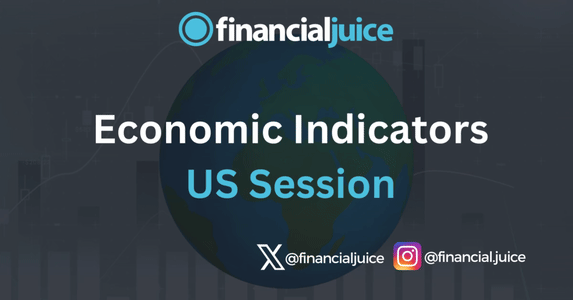
Week Ahead: Economic Indicators (US)
Hey, Traders!
For the September 2nd week, here is a list of all of the major economic indicators being released during the US Session, with a brief synopsis of what they represent and what to possibly expect from the markets in reaction.
Tuesday 3rd September
09:45 ET
US S&P Manufacturing PMI August Final
The US S&P Manufacturing Purchasing Managers’ Index is a monthly economic indicator compiled by S&P Global that measures the performance of the US manufacturing sector.
Based on surveys of purchasing managers, it assesses key aspects such as new orders, production levels, employment, and supplier delivery times.
As a diffusion index, a reading above 50 indicates growth in manufacturing activity, while a reading below 50 suggests contraction.
What to Expect
In the current economic situation, it is difficult to say what the markets will be paying attention to, due to volatile/mixed reactions to data points throughout the last month.
For the headline Manufacturing PMI, a higher-than-expected number could either show upside inflation risks, or a strong and resilient manufacturing sector, depending on the magnitude of the deviation.
This could cause either strength in the dollar and bond yields, with weakness in US stocks, or strength across the US assets (dollar, bond yields, and stocks).
The opposite could be seen if the number is lower then expected.
However, with employment in focus at the moment, I expect more attention will be paid to the employment component of this report.
If the employment situation is seen as stronger than expected in the manufacturing sector, I would expect to see strength across US assets (dollar, stocks, and bond yields), and the opposite if it is seen as weaker.
10:00 ET
US ISM Manufacturing PMI for August
The US Institute for Supply Management Manufacturing Purchasing Managers’ Index is a monthly economic indicator that measures the activity level in the US manufacturing sector.
Based on surveys of purchasing managers across various manufacturing industries, the index covers key areas such as new orders, production, employment, supplier deliveries, and inventories.
As a diffusion index, a reading above 50 indicates expansion in the manufacturing sector, while a reading below 50 signals contraction.
What to Expect
In the current economic situation, it is difficult to say what the markets will be paying attention to, due to volatile/mixed reactions to data points throughout the last month.
For the headline Manufacturing PMI, a higher-than-expected number could either show upside inflation risks, or a strong and resilient manufacturing sector, depending on the magnitude of the deviation.
This could cause either strength in the dollar and bond yields, with weakness in US stocks, or strength across the US assets (dollar, bond yields, and stocks).
The opposite could be seen if the number is lower then expected.
However, with employment in focus at the moment, I expect more attention will be paid to the employment component of this report.
If the employment situation is seen as stronger than expected in the manufacturing sector, I would expect to see strength across US assets (dollar, stocks, and bond yields), and the opposite if it is seen as weaker.
Differences between the US S&P & ISM Manufacturing PMIs
Survey Methodology
S&P Manufacturing PMI: Conducted by S&P Global, it surveys purchasing managers from a wide range of manufacturing industries. It includes a broader set of questions and emphasizes a more comprehensive set of indicators, such as output, new orders, and supplier delivery times.
ISM Manufacturing PMI: Managed by the Institute for Supply Management, it also surveys purchasing managers but focuses on a narrower set of indicators, including new orders, production, employment, supplier deliveries, and inventories.
Index Calculation
S&P Manufacturing PMI: Uses a weighted approach where each component contributes to the overall index based on its importance and the current economic environment.
ISM Manufacturing PMI: Uses a diffusion index approach where the percentage of respondents reporting improvements is compared to those reporting deteriorations, with the overall index reflecting the balance between expansion and contraction.
Focus and Components
S&P Manufacturing PMI: Includes a broader range of questions and may incorporate additional aspects of manufacturing activity.
ISM Manufacturing PMI: Focuses on core components directly tied to manufacturing activity and economic health.
Wednesday 4th September
08:30 ET
US Trade Balance for July
The US Trade Balance is a monthly economic indicator released by the Bureau of Economic Analysis (BEA) and the US Census Bureau that measures the difference between the value of the country’s exports and imports of goods and services.
A trade deficit occurs when imports exceed exports, while a trade surplus happens when exports exceed imports.
The trade balance is a key component of a country’s current account and reflects the demand for a country’s goods and services abroad as well as domestic demand for foreign goods.
It provides insights into the economic health and competitiveness of the US in the global market and can influence exchange rates & GDP.
What to Expect
This number is unlikely to create a meaningful market reaction without a large deviation from expectations.
Having said that, a deeper than expected deficit (lower than expected number) could cause weakness across US assets (dollar, stocks, and bond yields) due to its negative effect on US GDP, and the opposite could be true if it comes in higher than expected.
09:45 ET
Bank of Canada Rate Decision
The Bank of Canada Rate Decision is the announcement made by the Bank of Canada regarding changes to its key interest rate, known as the overnight rate.
This decision is made eight times a year and reflects the BoC’s assessment of the Canadian economy, inflation, and overall financial conditions.
The overnight rate influences borrowing costs for consumers and businesses and is a primary tool for the BoC to control inflation and support economic growth.
Changes in the rate can impact everything from mortgage rates to consumer spending and are closely watched by investors, economists, and policymakers for signals about future economic policy direction.
What to Expect
The median analyst estimate expects the BoC to keep rates unchanged at 4.5% at this meeting
However, market pricing suggests a 100% chance of a rate cut of 25 bps to 4.25% in light of the weakening Canadian jobs market.
This indicates that there could be a market reaction to this decision whether the rate is left unchanged or cut.
This means a cut could cause weakness in CAD and strength in Canadian stocks, whereas a decision to keep rates unchanged would likely cause strength in CAD and weakness in Canadian stocks.
Markets will also pay attention to the rhetoric used in the Rate Statement, most specifically, how it talks about future BoC rate decisions.
10:00 ET
US JOLTS Job Openings for July
US Job Openings and Labor Turnover Survey is a monthly report released by the Bureau of Labor Statistics (BLS) that provides data on the number of job openings, hires, quits, layoffs, and other separations in the United States.
It measures the demand for labor, offering insights into the labor market’s strength.
A high number of job openings indicates a strong demand for workers and a healthy job market, while a decline may suggest weakening demand.
What to Expect
A higher-than-expected job opening number, indicating good demand for labor, would likely cause strength across US assets (stocks, dollar, and bond yields), as it would reduce fears of a broader economic slowdown.
A lower-than-expected job openings number would likely do the opposite, as it instills further fears of a broader economic slowdown.
US Factory Orders for July
US Factory Orders is a monthly economic indicator released by the US Census Bureau that measures the dollar value of new orders placed with manufacturers for both durable and non-durable goods.
Durable goods are items expected to last at least three years, like machinery and appliances, while non-durable goods include products like food and clothing.
An increase in factory orders suggests rising demand for manufactured goods, signaling economic growth, while a decrease may indicate a slowdown in manufacturing and economic activity.
What to Expect
With this report being released at the same time as the JOLTS jobs report, and with employment more in focus at the moment, I would expect any reaction at this time to be to the jobs number as opposed to the Factory Orders number.
Having said that, strength in the manufacturing sector would decrease the chances of a recession, as it underlines a resilient economy, at least in this sector, which would likely prompt strength across US assets, and the opposite would likely be true if it came in lower than expected.
14:00 ET
Fed Beige Book
The Fed Beige Book is a report published eight times a year by the Federal Reserve, summarizing current economic conditions across the 12 Federal Reserve Districts in the United States.
The report gathers anecdotal information from business contacts, economists, market experts, and other sources within each district. It covers various aspects of the economy, such as consumer spending, employment, inflation,
and manufacturing activity.
The Beige Book provides qualitative insights into economic trends and helps the Federal Open Market Committee (FOMC) make informed decisions on monetary policy. Investors and analysts closely follow the Beige Book to gauge the economic outlook and anticipate potential policy changes.
What to Expect
The Beige Book is unlikely to garner a market reaction.
Having said that, the markets are attentive to the employment situation at the moment, so if the respondents note a marked strengthening or weakening in the labor market, this could cause US assets (stocks, dollar, and government bond yields) to strengthen or weaken respectively.
Thursday 5th September
08:15 ET
US ADP Employment Change for August
The US ADP Employment Change is a monthly report released by the ADP Research Institute that estimates the change in non-farm private sector employment in the United States.
It is based on payroll data from approximately 460,000 US businesses.
The report provides an early snapshot of the labor market ahead of the more comprehensive official employment report by the Bureau of Labor Statistics (BLS).
An increase in ADP employment change suggests job growth and economic expansion, while a decrease may indicate weakening labor market conditions.
What to Expect
With employment in focus at the moment, as the Fed focuses on the employment side of its mandate, higher-than-expected ADP numbers, indicating a stronger jobs market, would likely reduce fears of a larger slowdown, increase chances for a soft landing, and cause potential strength in US stocks and the dollar.
The opposite would be true if it came in lower than expected, as this would increase fears of a larger slowdown, reduce chances for a soft landing, and cause potential weakness in US stocks and the dollar.
08:30 ET
US Weekly Initial & Continued Jobless Claims
The US Weekly Initial & Continued Jobless Claims report, released every Thursday by the Department of Labor, tracks unemployment claims.
Initial claims measure the number of people filing for unemployment benefits for the first time, indicating new job losses.
Continued claims represent the number of people still receiving benefits after their initial claim, showing ongoing unemployment levels. These figures are key indicators of labor market health, with rising claims signaling potential economic weakness and declining claims indicating job market improvement.
What to Expect
With employment in focus at the moment, as the Fed focuses on the employment side of its mandate, higher-than-expected jobless claims numbers, indicating higher unemployment, would likely fuel fears of a deeper economic slowdown, and confirm the narrative in the markets that the Fed should have reduced rates in the last meeting when they had the chance to avoid a hard landing for the US economy.
This would likely cause weakness in US stocks and the dollar.
The opposite would be true if it came in lower than expected, as this would reduce fears of a larger slowdown, increase chances for a soft landing, and cause potential strength in US stocks and the dollar.
09:45 ET
US S&P Services PMI August Final
The US S&P Services Purchasing Managers’ Index is a monthly economic indicator compiled by S&P Global that measures the performance of the US services sector.
It is based on surveys of purchasing managers in various service industries, including finance, real estate, healthcare, and hospitality.
The index assesses business conditions based on factors such as new orders, employment, business activity, and input prices.
As a diffusion index, a reading above 50 indicates expansion, while a reading below 50 suggests contraction.
What to Expect
The service sector has been seen as a headwind for inflation by FOMC officials due to its sustained strength throughout the central bank tightening cycle.
However, with the focus shifting from inflation to employment, the other end of the Fed’s dual mandate, the employment breakdown in this report is perhaps more likely to cause a reaction than the headline Services PMI.
If the report underlines the employment situation strengthening, we could see strength across the US assets (dollar, stocks, and government bond yields) as it reduces the chances of a recession/hard landing for the US economy.
If the employment component come in weaker than expected, I would expect to see weakness across US assets, as the chance of a recession increases, and the Fed may be prompted to respond faster and harder to combat undue weakness in the US jobs market.
That is not to say that the market may not also react to the headline Services PMI number at all, which could add some volatility and unpredictability to the market reaction.
10:00 ET
US ISM Services PMI for August
The Institute for Supply Management Services Purchasing Managers’ Index is a monthly economic indicator that measures the activity level in the US services sector, which includes industries such as retail, healthcare, and finance.
It is based on a survey of purchasing managers, who provide insights into business conditions such as new orders, employment, and prices.
As a diffusion index, a reading above 50 indicates expansion in the services sector, while a reading below 50 signals contraction.
What to Expect
The service sector has been seen as a headwind for inflation by FOMC officials due to its sustained strength throughout the central bank tightening cycle.
However, with the focus shifting from inflation to employment, the other end of the Fed’s dual mandate, the employment breakdown in this report is perhaps more likely to cause a reaction than the headline Services PMI.
If the employment situation comes in higher than expected, we could see strength across the US assets (dollar, stocks, and government bond yields) as it reduces the chances of a recession/hard landing for the US economy.
If the employment component comes in lower than expected, I would expect to see weakness across US assets, as the chance of a recession increases, and the Fed may be prompted to respond faster and harder to combat undue weakness in the US jobs market.
That is not to say that the market may not also react to the headline Services PMI number at all, which could add some volatility and unpredictability to the market reaction.
Differences between the US S&P & ISM Services PMIs
Survey Methodology
S&P Services PMI: Conducted by S&P Global, it surveys purchasing managers across a broad range of service industries. It includes questions about business activity, new orders, employment, and prices, and reflects a broad view of service sector performance.
ISM Services PMI: Managed by the Institute for Supply Management, it surveys purchasing and supply executives in the services sector, focusing on key areas such as business activity, new orders, employment, and supplier deliveries.
Index Calculation
S&P Services PMI: Uses a weighted approach, where the components of the index are weighted according to their relevance and current economic conditions. It provides a more comprehensive view of the services sector.
ISM Services PMI: Uses a diffusion index approach, comparing the percentage of respondents reporting improvements versus those reporting declines, and is intended to capture the balance between expansion and contraction.
Components and Focus
S&P Services PMI: Typically includes a broader range of indicators and provides a snapshot of overall business conditions, including detailed components like business expectations and input costs.
ISM Services PMI: Focuses on core indicators such as business activity, new orders, employment, and supplier deliveries, and may provide more specific insights into operational aspects.
Reporting and Interpretation
S&P Services PMI: Provides an early, detailed snapshot of the services sector, often including a comprehensive summary of current business conditions and expectations.
ISM Services PMI: Offers detailed insights into service sector activity with a focus on core operational metrics and is widely used for its detailed analysis and historical data.
11:00 ET
US Weekly EIA Crude Oil Inventories
The US Weekly EIA Crude Oil Inventories report, released by the Energy Information Administration every Wednesday, provides data on the current amount of crude oil held in storage across the United States.
This report helps gauge supply and demand dynamics in the oil market and can influence oil prices and market sentiment.
What to Expect
An increase in inventories suggests lower demand or higher supply, creating a potential downside in oil prices, while a decrease indicates higher demand or lower supply, causing a possible strengthening in oil prices.
Friday 6th September
08:30 ET
US Employment Situation for July
US Nonfarm Payrolls
US Nonfarm Payrolls, commonly referred to as NFP, is a key economic indicator published by the Bureau of Labor Statistics on a monthly basis.
It represents the total number of paid workers in the US, excluding farm employees, government workers, and non-profit organization employees.
The NFP report provides insights into the overall health of the labor market, reflecting changes in employment levels.
The data is closely watched by policymakers, economists, and investors for its impact on financial markets and economic policy decisions.
US Unemployment Rate
The US Unemployment Rate is a widely tracked economic indicator that measures the percentage of the labor force that is unemployed and actively seeking employment.
It is calculated by dividing the number of unemployed individuals by the total labor force.
The Unemployment Rate can differ from the Nonfarm Payrolls data due to differences in their definitions and methods of measurement.
While NFP represents the total number of paid workers in the US, excluding certain categories like farm and government employees, the Unemployment Rate considers the percentage of the labor force that is actively seeking but unable to find employment and is conducted via household surveys as opposed to payrolls data.
US Average Earnings YoY
US Average Earnings Year-over-Year is an economic indicator that measures the annual percentage change in the average earnings of all non-farm employees in the United States.
Average earnings include wages and salaries, and the YoY comparison helps assess the rate of change in workers’ compensation over a one-year period.
Positive growth in Average Earnings YoY is indicative of increasing income levels, while negative growth suggests a decline in average earnings. This data point gives insights into wage trends and their implications for consumer spending and inflation.
What to Expect
The US nonfarm payrolls is the most highly monitored employment indicator by both traders and policymakers.
Employment has been in focus since the last Nonfarm Payrolls report on August 2nd, which showed an unexpected weakening in the labor market, and prompted FOMC officials to pay greater attention to the employment situation.
Since then, markets have been reacting to employment reports for their effect on the broader economy, as opposed to it’s effects on monetary policy.
With that being said, if Nonfarm Payrolls comes in higher than expected, and the Unemployment Rate comes in lower than expected, there would likely be strength across the US assets (US stocks, dollar, and government bond yields) as it decreases the likelihood of recession/broader economic slowdown, increasing the chances for a soft landing.
If NFP comes in lower than expected, and the Unemployment Rate comes in higher than expected, I would expect weakness across the US stocks, dollar, and government bond yields, as we saw with the previous Nonfarm Payrolls report.
This would solidify the scenario of a broader economic slowdown, which increases the chances of a hard landing/recession, and would prompt the Fed to move faster and harder in terms of policy response to react to the slowdown in the jobs market.
Canadian Employment Change & Unemployment Rate
Canadian Employment Change is a monthly economic indicator released by Statistics Canada that measures the net change in the number of employed people in the country compared to the previous month.
It includes both full-time and part-time employment and provides insights into the health of the Canadian labor market.
An increase in employment typically signals economic growth, while a decrease may suggest economic weakness.
Unemployment Rate is also reported monthly by Statistics Canada and represents the percentage of the labor force that is unemployed and actively seeking work.
It is calculated by dividing the number of unemployed individuals by the total labor force.
A rising unemployment rate can indicate economic challenges or slowing job creation, while a falling rate suggests improving labor market conditions.
What to Expect
If Canadian Employment comes in lower than expected (and the unemployment rate comes in higher than expected) this could warrant the pricing in for a continuation of rate cuts from the BoC, which would be likely to cause weakness in CAD and strength in Canadian Stocks.
The opposite could also be true, if employment comes in higher than expected, this could cause markets to price in a hold on BoC rate cuts, which could cause strength in CAD and weakness in Canadian stocks.





